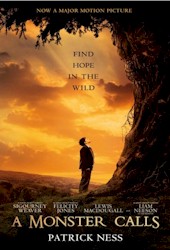A Monster Calls
Directed By: J. A. Bayona
Screen Play By: Patrick Ness
Based On: A Monster Calls by Patrick Ness from an idea by Siobhan Dowd
Starring: Sigourney Weaver, Felicity Jones, Toby Kebbell, Lewis MacDougall, Liam Neeson
Music By: Fernando Velázquez
Narrated By:
Produced By: Belén Atienza, Mitch Horwits, Jonathan King
Production: Participant Media River, Road Entertainment, Apaches Entertainment, Telecinco Cinema, Peliculas La Trini
Release Date: September 10, 2016 (TIFF), October 7, 2016 (Spain), January 1, 2017 (United Kingdom)Plot: 12-year-old Conor O'Malley has a close bond with his seriously ill mother and maintains the household during her regular chemotherapy treatments at the hospital. His grandmother often visits, and suggests he come live with her in the event of his mother's death. Conor doesn't warm to her due to her coldness.
At school, he is regularly tormented by his classmate Harry. He is also plagued by a nightmare in which the old church near his house collapses into a hole, where he tries to prevent someone from plummeting to their death by trying to hold onto them. Conor vents his emotions by drawing, a talent inherited from his mother.
One night at exactly seven minutes past midnight, he sees the large yew tree next to the church transform into a gnarled Monster that approaches his home. The Monster says it will tell Conor three stories during their next meetings, after which Conor must tell the Monster a fourth tale in return.
In the Monster's first story, a prince escapes from his stepgrandmother, the supposedly evil queen. He then kills his sleeping bride under a yew tree and makes the queen the scapegoat so the people drive her away and make him king.
As Conor's mother worsens, he moves in with his grandmother. In the evening, Conor summons the Monster by forcing the hands of the clock to show 12:07. He appears, and tells the second story. In the tale, a hard-hearted parson forbids an apothecary from extracting medicine from an old yew tree, only to rescind this measure when his own children become ill. The apothecary refuses to help him, and the Monster begins to destroy the parson's house as punishment. Conor enthusiastically joins in on the destruction, but he suddenly finds he has angrily destroyed his grandmother's sitting room and valuable grandfather clock instead. His grandmother, while shocked and upset, does not punish Conor.
The doctors turn to a final treatment involving yew wood. Conor implores the Monster to heal his mother, only for the Monster to dismiss the matter as outside of his responsibility. At school, Harry tells Conor he will no longer bother him because he "no longer sees [him]". The Monster tells the third story of an invisible man who did not want to be so. Conor angrily attacks Harry, hospitalizing him. To his surprise, the headmistress refrains from punishing him as she comprehends his current home situation.
Review: This is a deeply moving movie. As the subject matter is one that can touch and affect you on many emotional levels. So it would not be suitable for a younger audience. The story centres on a 13 year old boy named Conor, who is dealing with the his Mothers terminal illness. As he feels crushed under the pain and anguish of losing a parent and not being able to do anything is complicated with a visit from loud and scary monster that tells stories that will challenge everything he believes. These stories with the main story are violent and bloody. Each with a deeper lesson about the complex matrix of human emotions, fears and hopes. The concept of a story within a story is in some ways reminiscent of Shakespeare's plays. Where several stories are played out.
There is a piercing sadness that runs through the film. The main protagonist is relatable and you become connected with Conor from the start. Feeling his pain and angst as he struggles with life and the ultimate death of his Mother. The film is a difficult yet poignant portrayal of one of life and death and coming to terms with painful loss.
As Christians we have a different understanding of death than the world. We accept that through Jesus the Christ we are set free from death and given an eternal home in heaven. When someone we love, and who trusts in the Lord, has passed away; we grieve for our loss. But we also celebrate in their entrance into heaven. We also look forward to the time when we will be with them once again. This film may be viewed vastly differently between those who have salvation and those who don't. Yet it is still a valuable visual lesson in grief and loss. One that is well worth experiencing and learning from.
M J Flack
